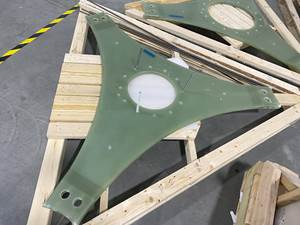Composites industry is growing up—but hurdles still remain
It’s the era of when, not if, for the use of composite materials.
It’s Jan. 19 as I write this, and tomorrow, in the United States, a new president will take the oath of office. What, exactly, the Trump Administration will look like, and how it will behave, remains to be seen. What’s certain is that change is afoot, and by the time you read this, perhaps there will be some clarity about the nature of that change. There was much discussion during and after the General Election campaign about policies the new administration might pursue: Tax reform, healthcare reform, regulation reform, new trade agreements, immigration reform, etc. There also has been talk about increased government investment, designed to stimulate economic activity. At the top of this much-examined list has been infrastructure — the roads, bridges and tunnels on which we all rely, mainly for transportation.
This is exciting for the composites industry because composites are ideal for concrete rehabilitation. It’s also daunting because the folks who do infrastructure maintenance and repair are highly dependent on legacy materials, and they are not fully convinced of the benefits that composites can provide. Composites haven’t “earned” their way into the infrastructure brotherhood of materials yet.
If you’ve been in the industry for even a short time, you likely have heard the “earned” terminology before. It’s been used in end-markets whenever composites have tried to break through, vying against whatever the legacy materials of choice were at the time: Wood, aluminum, steel, titanium, concrete, etc.
If you haven’t noticed, however, we’re running out of end-markets in which composites have not yet earned a seat at the table. The marine end-market, of course, was conquered by composites long, long ago. They are used so pervasively there now, that composites have become the rule to which every other material is the exception. The same goes for wind energy, where composites were and still are the enabler that made the fabrication of the blades that turn the turbines practical.
In aerospace, since the advent of the Boeing 787 and Airbus A350 XWB, the question commercial aircraft OEMs face is not if composites should be used, but only where and how much. Even the production automotive body-in-white, so tantalizingly out of reach for so long, seems finally to be the target of a gradual composites adoption effort that promises to usher in new ways of designing and making composite structures.
Similarly, there is an effort across many end-markets — automotive, aerospace, architecture, to name a few — to integrate composites into multi-material solutions that marry carbon and glass fiber-reinforced composites with metals to affordably meet a host of weight and strength goals. Such applications prove that composites are becoming a material staple, and less an exotic and unusual outlier.
Finally, we must look at what’s happening in the investment community. In the past 18 months alone we have seen substantial mergers and acquisitions activity, with large, established firms, 
as well as private equity firms, investing heavily in composites industry stalwarts: Teijin buying Continental Structural Plastics, Solvay Specialty Polymers buying Cytec, GKN buying Fokker Aerostructures, Hexcel acquiring Formax, Tennessee Acquisition BV buying Royal TenCate, Meggitt buying Cobham, Precision Castparts acquiring Composites Horizons. And there are more to come.
What does all of this mean? In short, the composites industry is growing up. This is isn’t to say that there aren’t hurdles yet to clear. As the infrastructure market proves, acceptance of composites is not universal. Challenges remain in the areas of materials, design engineering, automation and processing speed.
Still, the composites industry has clearly established a firm footing in the global manufacturing supply chain, and it’s seen not only as interesting and viable, but also as prospering and profitable, and thus has become a high-value target in the wider business community. Composites have clearly earned their way into the manufacturing world.
Related Content
RTM, dry braided fabric enable faster, cost-effective manufacture for hydrokinetic turbine components
Switching from prepreg to RTM led to significant time and cost savings for the manufacture of fiberglass struts and complex carbon fiber composite foils that power ORPC’s RivGen systems.
Read MorePlant tour: Hexagon Purus, Kassel, Germany
Fully automated, Industry 4.0 line for hydrogen pressure vessels advances efficiency and versatility in small footprint for next-gen, sustainable composites production.
Read MoreComposites end markets: Batteries and fuel cells (2024)
As the number of battery and fuel cell electric vehicles (EVs) grows, so do the opportunities for composites in battery enclosures and components for fuel cells.
Read MoreWe4Ce infused 2.5-3-MW rotor blade design passes validation test
Composite rotor blade structure design by We4Ce, mold and prototype production by InDutch Composites and fatigue testing by Suzlon Group has resulted in the novel blade’s IEC61400-5:2020 certification.
Read MoreRead Next
Scaling up, optimizing the flax fiber composite camper
Greenlander’s Sherpa RV cab, which is largely constructed from flax fiber/bio-epoxy sandwich panels, nears commercial production readiness and next-generation scale-up.
Read MoreCeramic matrix composites: Faster, cheaper, higher temperature
New players proliferate, increasing CMC materials and manufacturing capacity, novel processes and automation to meet demand for higher part volumes and performance.
Read MoreNext-gen fan blades: Hybrid twin RTM, printed sensors, laser shock disassembly
MORPHO project demonstrates blade with 20% faster RTM cure cycle, uses AI-based monitoring for improved maintenance/life cycle management and proves laser shock disassembly for recycling.
Read More









